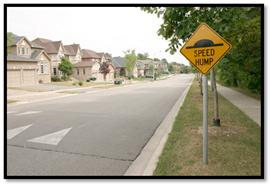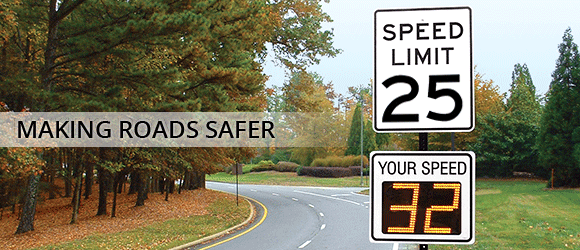TRAFFIC-CALMING TRENDS: Antiquated, Knee-Jerk Response to Speeding Drivers Now Being Rejected Around the World
 Every day, municipalities, HOAs and school districts across the nation face problems with speeding drivers. For decades, speed humps were the only traffic-calming solution available. Today, the antiquated speed hump—a traditionally popular solution to speeding drivers—has become a controversial lightning rod in conversations involving traffic-calming solutions coast-to-coast and around the world.
Every day, municipalities, HOAs and school districts across the nation face problems with speeding drivers. For decades, speed humps were the only traffic-calming solution available. Today, the antiquated speed hump—a traditionally popular solution to speeding drivers—has become a controversial lightning rod in conversations involving traffic-calming solutions coast-to-coast and around the world.
Contemporary wisdom now recognizes the shortcomings of and frustrations associated with speed humps. Media report that speed humps:
- Are expensive to install and expensive to maintain—Speed humps can cost $4,500 to $7,500. [Source: The Washington Post, Sept. 9, 2008]
- Interfere with response times of emergency vehicles—Each speed hump costs fire trucks ten seconds in response time. [Source: ABC Orlando/WFTV, Jan. 28, 2010; and Fire Capt. Jeffrey Martin, St. Petersburg Times, Feb. 2, 2008; and the Tampa Tribune, Sept. 20, 2008]
- Reduce property values—Prospective homebuyers reject home sites near speed humps. [Source: Tampa Bay Online, Sept. 30, 2009]
- Increase noise levels—Speed humps usher in a constant barrage of scraping cars and engines revving over the humps. [Source: Tampa Bay Online, Aug. 12, 2009]
- Increase wear and tear on residential and commercial vehicles—Speed humps are a source of excessive wear on tires, brakes, suspension systems, shock absorbers and rattle dashboards. [Source: The Natchez Democrat, Oct. 28, 2009]
- Expensive to remove—Municipalities, under pressure by citizens and enforced by the courts, have been forced to remove speed humps at great expense to tax payers. [Source: Tampa Bay Online, Sept. 30, 2009]
- Increase air pollution—On roads with speed humps, carbon monoxide emissions increase by 82 percent, carbon dioxide emissions double and nitrogen oxide increases by 37 percent. [Source: BBC.com, April 22, 2009]
- Reduce fuel efficiency and increase gas consumption—By forcing drivers to brake and accelerate repeatedly, speed humps will cause a car that normally that gets 58.15 mpg travelling at a steady 30mph to deliver only 30.85 mpg. [Source: BBC.com, April 22, 2009]
Additionally, some have observed that speed humps do not change driver behavior and encourage other dangerous driving behaviors, such as going “off road” to avoid the humps.
Situation Analysis:
In 2008, in Hillsborough County, Florida some of the Carrollwood community faced significant traffic-calming dilemmas. Dangerous driver speeds had caused the roads to become unsafe for pedestrians, cyclists and other drivers. In response, the county invested $2 million in hundreds of speed humps, cushions and other devices. Within a short period of time, complaints about the speed humps began to pour in from residents, tourists and emergency responders who demanded a better solution.
As documented in the final “Neighborhood Traffic Calming Arbitration” report, Carrollwood Village residents expressed specific concerns and requests related to the speed humps:
- “Traffic calming could have been better controlled in a more cost-effective manner through the use of speed limit flashing signs that note the speed in which the car is approaching. The speed bumps are excessive; promote unnecessary cost for continued maintenance and, over time, cause wear and tear on car alignment and shocks.” T.B.
- “… (the speed hump) creates an unacceptable delay in emergency response…” K.K.
- “Speed humps cause damage to automobiles and increased noise from.” M.F.
- “Safety, fire hazards—Noise pollution. Horrendous disfigurement of the neighborhood. Get rid of all of them. Use electronic feedback signs.” N.K.
- “My brother’s death could have been the result of four speed bumps.” W.C.
- “Speed bumps are irritating and upsetting and painful. It’s the same as going over chuck holes. Speed bumps make traffic speed unpredictable as some vehicles don’t slow down.” D.C.
- “Numerous speed humps and tables slow down response time to emergency vehicles[and subject automobiles to]obstacles which contribute the excessive wear and tear to my vehicles.” L.B.
The controversy was settled legally in 2009 when arbitrators ruled that about one-third of the newly installed speed humps should be removed. The result: Hillsborough county has spent at least $200,000 to remove the speed humps in Carrollwood Village alone.
Resolution:
Time and technology have eclipsed the traditional fix. Residents and community leaders—armed with online access to information and vendors—expect and demand an improved solution that could accommodate a broad range of needs.
In addition to speed hump removal, the arbitration report also recommended the installation of additional driver feedback signs—a solution that had been part of the original plan but delayed due to the controversy. With some 40 driver feedback signs to be installed within a beautiful residential setting, cost and aesthetic appeal became primary considerations. Local community leaders Libbie Jae and Jennifer Fritch spearheaded the search for a cost-effective and attractive solution.
“Driver feedback signs are subtle but very effective reminders to drivers without all the noise and disruption of speed humps, which have been quite divisive,” says Libbie Jae. “Radarsign offers a great solution that answered all of our needs: Not only are the signs silent and attractive, they are also very affordable and the solar power option makes them a green solution. I just see Radarsign as a win-win all the way around.”
Related Stories:
- April 2010, Columbia News Service: Millburn Township in New Jersey is forced to remove five of eight speed humps. Taxpayers estimated to foot the loss of $8,000 in installation costs plus removal fees.


